
|
||||||||||
|
||||||||||
| Favorite Tweets by @thaibirding | ||||||||||
|
||||||||||
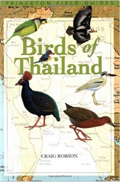 Buy Birds of Thailand on Amazon.co.uk |
||||||||||
| Site Map ; Contributors |
| Timing
and abundance of Grey-faced Buzzards Butastur indicus and
other raptors on northbound migration in southern Thailand, spring
2007–2008 By Robert DeCandido & Chukiat Nualsri |
||||||||||||||||||||||||||||||||||||||||||||||||||||||||||||||||||||||||||||||||||||||||||
| Tweet | ||||||||||||||||||||||||||||||||||||||||||||||||||||||||||||||||||||||||||||||||||||||||||
| Note:
This article was originally published in Forktail 25 (2009) the journal
of the Oriental
Bird Club (OBC) and was kindly submitted by Robert
DeCandido. Please support the OBC's conservation work by visiting the OBC website and becoming a member. |
||||||||||||||||||||||||||||||||||||||||||||||||||||||||||||||||||||||||||||||||||||||||||
| ABSTRACT We provide the first extensive migration data about northbound migrant raptors in Indochina. Daily counts were made at one site (Promsri Hill) in southern Thailand near the city of Chumphon, from late February through early April 2007–08. We identified 19 raptor species as migrants, and counted 43,451 individuals in 2007 (112.0 migrants/hr) and 55,088 in 2008 (160.6 migrants/hr), the highest number of species and seasonal totals for any spring raptor watch site in the region. In both years, large numbers of raptors were first seen beginning at 12h00, and more than 70% of the migration was observed between 14h00 and 17h00 with the onset of strong thermals and an onshore sea breeze from the nearby Gulf of Thailand. Two raptor species, Jerdon’s Baza Aviceda jerdoni and Crested Serpent Eagle Spilornis cheela, were recorded as northbound migrants for the first time in Asia. Four species composed more than 95% of the migration: Black Baza Aviceda leuphotes (mean 50.8 migrants/hr in 2007–08), Grey-faced Buzzard Butastur indicus (47.5/hr in 2007–08), Chinese Sparrowhawk Accipiter soloensis (22.3/hr in 2007–08), and Oriental Honey-buzzard Pernis ptilorhynchus (7.5/hr in 2007–08). Most (>95%) Black Bazas, Chinese Sparrowhawks and Grey-faced Buzzards were observed migrating in flocks. Grey-faced Buzzard flocks averaged 25–30 birds/ flock. Seasonally, our counts indicate that the peak of the Grey-faced Buzzard migration occurs in early to mid-March, while Black Baza and Chinese Sparrowhawk peak in late March through early April. Oriental Honey-buzzard migrated throughout the observation period, with a peak in mid- to late March. |
||||||||||||||||||||||||||||||||||||||||||||||||||||||||||||||||||||||||||||||||||||||||||
| INTRODUCTION In the last decade, there has been increasing interest in raptor migration in Indochina (DeCandido et al. 2008). Scientists investigating this East Asian Continental Flyway have used satellite telemetry to follow Oriental Honey-buzzards Pernis ptilorhynchus to determine migration timing, stopover sites, and differences between routes selected by males vs females vs immatures (Higuchi et al. 2005, Shiu et al. 2006). Others have established ‘watch sites’ to assess the numbers of migrants and species seen in Thailand and Malaysia (DeCandido et al. 2004, 2006, Lim and Cheung 2007, 2008). Yet our knowledge of raptor migration through Indochina, particularly during northbound migration, is limited. Here we provide the first extensive spring migration data for the region, including the number of raptor species and individuals involved, and their seasonal timing while heading north through the continent. |
||||||||||||||||||||||||||||||||||||||||||||||||||||||||||||||||||||||||||||||||||||||||||
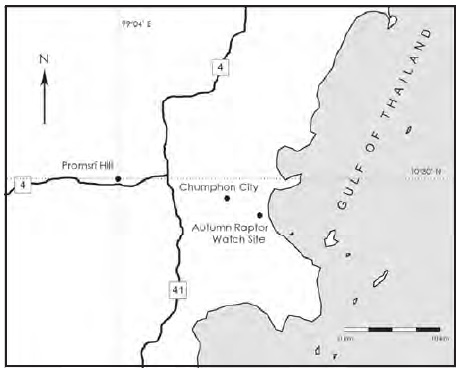 Figure 1. Map of south-central Thailand showing the Promsri Hill raptor migration watch site in relation to Chumphon City, the main road (Route 4), and the autumn raptor watch site used since 2000. |
||||||||||||||||||||||||||||||||||||||||||||||||||||||||||||||||||||||||||||||||||||||||||
| In March 2003, large numbers of northbound migrating raptors were first observed by CN west of the town of Chumphon on the Isthmus of Kra in southern Thailand (Fig. 1). Periodic observations by CN in February through April 2004–2006 confirmed a significant migration pathway in the area. These raptors are returning to breed in eastern Russia and southern China, west through parts of Siberia, Nepal, Mongolia and Korea, as far east as Japan (Fig. 2). | ||||||||||||||||||||||||||||||||||||||||||||||||||||||||||||||||||||||||||||||||||||||||||
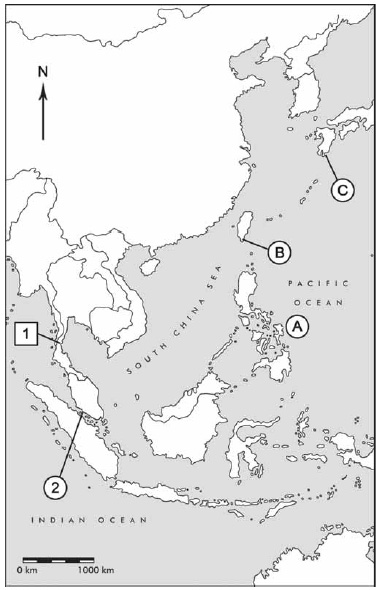 Figure 2. Map of East Asia showing the two primary continental spring raptor migration count sites: (1) Promsri Hill (Thailand) and (2) Tanjung Tuan (West Malaysia). Also shown in the primary oceanic migration corridor of northbound Grey-faced Buzzards in spring: (A) Philippine Islands, (B) Taiwan, and (C) Japan. |
||||||||||||||||||||||||||||||||||||||||||||||||||||||||||||||||||||||||||||||||||||||||||
| We
were particularly interested in documenting the abundance and passage
timing of Grey-faced Buzzard Butastur indicus. Previous
research focused on the segment of the population that migrates
by island-hopping through the East Asian Oceanic Flyway via Japan
and Taiwan to winter in the Philippine Islands to Sulawesi and New
Guinea (Kugai 1996, Shiu et al. 2006, Germi et al.
2009). However, little is known about the continental migrant population
we observed in spring 2007–08. Though Grey-faced Buzzards
are common October migrants in Thailand (DeCandido et al.
2004), further south in the Thai-Malay Peninsula this species is
a rare to uncommon migrant in either season in Singapore and at
Tanjung Tuan on the west coast of Malaysia (Wells 1999). From a broader perspective, we had specific research questions about spring raptor migration in South-East Asia. (1) What raptor species migrate through the region in spring vs autumn? (2) What is the daily pattern of raptor migration at our Promsri Hill watch site in southern Thailand: is there a late morning peak with declining numbers seen for the remainder of the day, similar to that observed during southbound migration in autumn 2003 at a watch site some 20 km east-south-east (see DeCandido et al. 2004)? (3) What is the seasonal pattern of spring migration for raptors commonly seen here including Black Baza Aviceda leuphotes, Oriental Honey-buzzard, Chinese Sparrowhawk Accipiter soloensis and Grey-faced Buzzard? (4) How do weather variables, such as wind direction, affect the migration observed at our watch site? By addressing such questions, we hope to provide information to biologists, conservationists and birdwatchers interested in understanding a crucial time in the life history of Asian migratory raptors. |
||||||||||||||||||||||||||||||||||||||||||||||||||||||||||||||||||||||||||||||||||||||||||
| METHODS In late February through early April 2007–08, we made daily counts of migrant raptors, two bee-eater species and other land birds from a site 15 km west of Chumphon City (10°28’N 99°13’E, sea-level), known locally as Promsri Hill or Khao Klai. The watch site (10°30’N 99°04’E) sits on the crest of a hill, c.5 km west of the main N–S highway (Phetkasem Road, Highway 4) and 475 km south-west of Bangkok (Fig. 1). The site afforded an unobstructed 360º view of northbound migrants. The hill is the southern terminus of a low S–N ridge on military land, and is accessible by permit only. Much of this ridge is comprised of seasonal grasses, scrub and second growth, on average less than 2 m in height. Most of the surrounding area and nearby hills have been developed for pasture and agriculture (banana, oil palm), with second-growth forest occupying perhaps the upper 10% of these hills. On clear days it was possible to see east c.25 km to the Gulf of Thailand; south c.5 km to a tall hill (Khao Thai Dang); west c.10 km to a hill (Khao Nam Lod) that is part of a south to north ridge system; and north c.3 km. This spring migration watch site (Promsri Hill) is c.15 km west-north-west of the autumn watch site used since 2000. Observations by CN each spring from 2004 through 2006 suggested that few migrants pass the vicinity of the autumn watch site. Instead, Promsri Hill was selected for spring migration research because it afforded the best combination of height above the surrounding lowlands, proximity to significant numbers of migrants, and ease of access. Earlier in the day, from about 08h00 until 10h00, the migration is best observed at the intersection of Highway 4 and Highway 41 (Fig. 1). However, overall more migrants pass to the west of this intersection, and these are more easily seen from Promsri Hill. In both years, we measured hourly the wind speed and direction, temperature, humidity and barometric pressure with a hand-held weather station (Kestrel 4000, Nielsen- Kellerman Corporation, U.S.A.). Wind direction was determined with a compass. Weather conditions typically were hazy and humid with little wind in the morning until 09h00, then becoming clear with cumulus clouds. Until c.09h00 to as late as c.11h00 each day, light westerly winds (less than 10 km/hr) prevailed, then switching easterly due to the interaction of the north-east low pressure monsoon (Guo et al. 2002) combined with a sea-breeze from the nearby Gulf of Thailand (Khedari et al. 2002). However, the exact timing of the wind switch varied greatly in 2007 compared to 2008, as did the intensity of these easterly winds. Raptors were counted with binoculars by RDC with help from CN. Others visited the site after 14h00 most days and helped to locate distant flocks of migrants. We made daily counts during two spring seasons: in 2007, from 28 February through 3 April (35 days; 388 hours of observation); and in 2008, from 28 February through 31 March (32 days; 343 hours of observation). Observations usually began by 07h00 local time, and ended by 18h30 each day. During inclement weather such as thunderstorms, we remained in the area of the watch site looking for migrants. For one day in 2008 (10 March), when it rained all day, no count was made. CN also made periodic observations of up to three days per week from late January through February 2003–2006, and again in April to mid-May 2009. To locate migrating raptors, observers scanned from the west-south-west to the east. To identify migrants, we consulted Lekagul et al. (1991), Wells (1999), Herremans and Louette (2000), Robson (2002) and Kasordorkbua et al. (2008). Scientific names follow Inskipp et al. (1996, 2001). Raptors were considered migrants if they passed south to north across an imaginary east–west line at the watch site, and continued north and out of sight. We did not attempt to age or sex migrants. We defined a flock of migrating raptors as any group of at least two individuals passing the watch site within c.3 minutes of one another. Most raptors were observed migrating within 3 km of the watch site. Beyond c.5 km it was very difficult to detect and identify a lone migrant, or small flocks of certain species such as Chinese Sparrowhawk. To evaluate the daily and seasonal pattern of raptor migration, we pooled the data of all individuals we counted at the site, including migrants we could not identify to species. To determine the seasonal peak for the commonest raptor species in 2007 and 2008, we used the highest ten-day average in each year. In Table 1, for the highest daily count of individuals for species for which we saw only one migrant on two different dates, we chose the first date as the peak. We also calculated a median date (the day at which 50% of the individuals of a particular species had been counted) of peak passage for the four commonest raptors by pooling 2007–08 data for each of these species. We hypothesised that more raptors would pass the watch site when winds had an easterly component (NE to SE), than when winds were from other directions, usually west to south. We used a chi-square test with one degree of freedom (Preacher 2001) to analyse the effect of wind direction on the number of raptors passing the watch site when winds from these two general directions prevailed. |
||||||||||||||||||||||||||||||||||||||||||||||||||||||||||||||||||||||||||||||||||||||||||
| RESULTS In spring 2007–08, a total of 98,539 raptors of 19 species was counted, averaging 112.0 migrants/hr in 2007, and 160.6 migrants/hr in 2008 (Table 1). Four species comprised >95% of the migration in 2007–08: Black Baza (38%), Grey-faced Buzzard (35%), Chinese Sparrowhawk (17%) and Oriental Honey-buzzard (6%). Three of these were primarily seen in single-species flocks: Black Baza, Grey-faced Buzzard and Chinese Sparrowhawk. In spring 2008, we counted 8,954 (63%) more Black Bazas and noted three additional raptor species vs our spring 2007 count (Table 1). |
||||||||||||||||||||||||||||||||||||||||||||||||||||||||||||||||||||||||||||||||||||||||||
| Table 1. Raptor species, numbers counted, and seasonal peaks at Promsri Hill, Chumphon, Thailand, in spring 2007–2008. | ||||||||||||||||||||||||||||||||||||||||||||||||||||||||||||||||||||||||||||||||||||||||||
|
||||||||||||||||||||||||||||||||||||||||||||||||||||||||||||||||||||||||||||||||||||||||||
| In both years, large numbers of raptors began to pass the watch site beginning at 12h00 (Fig. 3), with most (>70%) migrants observed between 14h00 and 17h00. From c.08h00 to 09h30 the migration passed c.5 km to the east of Promsri Hill following the route of the main road (Highway 4), and gradually shifted further west throughout the morning (Fig. 1). In 2007, the highest hourly count (1,686) occurred between 14h00 and 15h00 on 29 March. In 2008, the highest hourly count (2,768) occurred between 16h00 and 17h00 on 30 March. Large numbers of Black Bazas accounted for these high totals. In 2007–08, significantly greater numbers of migrant raptors passed the watch site when winds were easterly (NE, E or SE) than when winds were from other directions (?² = 1190.5, p < 0.05, df = 1). | ||||||||||||||||||||||||||||||||||||||||||||||||||||||||||||||||||||||||||||||||||||||||||
 Figure 3. Mean number of raptors counted per hour at Promsri Hill, Thailand during spring 2007–08. |
||||||||||||||||||||||||||||||||||||||||||||||||||||||||||||||||||||||||||||||||||||||||||
| Figure
4 shows the daily totals of the four commonest migrant raptor species
observed at Promsri Hill in spring 2007–08. For Black Baza
in 2007–2008, we counted 50.8 migrants/hr. The two-year median
date for peak passage was 25 March. In 2007, the peak ten-day migration
period for Black Baza occurred from 21 March to 30 March (Fig. 4a),
averaging 932.0 migrants/day and 80.0 migrants/hr. In 2008, the
peak time-frame also occurred from 21 March to 30 March (Fig. 4a),
averaging 1,954.5 migrants/day and 176.9 migrants/hr. The highest
single-day count of migrating Black Bazas was 4,334 on 24 March
2008 (Table 1). Fewer than 100 total migrants of this species were
observed at Promsri Hill after 5 April in 2009, and we consider
their migration complete by mid-April in southern Thailand. For Oriental Honey-buzzard in 2007–2008, we counted 7.5 migrants/hr. The two-year median date for peak passage was 19 March. In 2007, the peak ten-day migration period occurred from 19 March to 28 March (Fig. 4b), averaging 161.8 migrants/day and 13.9 migrants/ hr. In 2008, the migration peak occurred from 11 March to 20 March (Fig. 4b), averaging 157.6 migrants/day and 14.5 migrants/hr. The highest single-day count of migrating Oriental Honey-buzzards was 285 on 25 March 2007 (Table 1). In past years, the earliest birds were seen on 1 February 2004 (CN). In observations during April through mid-May 2009, CN observed up to 100 Oriental Honey-buzzards per day in migration as late as 8 May. For Chinese Sparrowhawk in 2007–2008, we counted 22.3 migrants/hr. The two-year median date for peak passage was 26 March. In 2007, the peak ten-day migration period for this species occurred from 21 March to 30 March (Fig. 4c), averaging 447.5 migrants/day and 38.4 migrants/hr. In 2008, the peak time-frame also occurred from 21 March to 30 March (Fig. 4c), averaging 739.0 migrants/day and 66.9 migrants/hr. The highest singleday count of migrating Chinese Sparrowhawks was 1,391 on 30 March 2007 (Table 1). In early April 2009, totals of 200–300 were seen in migration per day. However, numbers declined rapidly after 5 April, although singles passed the watch site through early May (CN). |
||||||||||||||||||||||||||||||||||||||||||||||||||||||||||||||||||||||||||||||||||||||||||
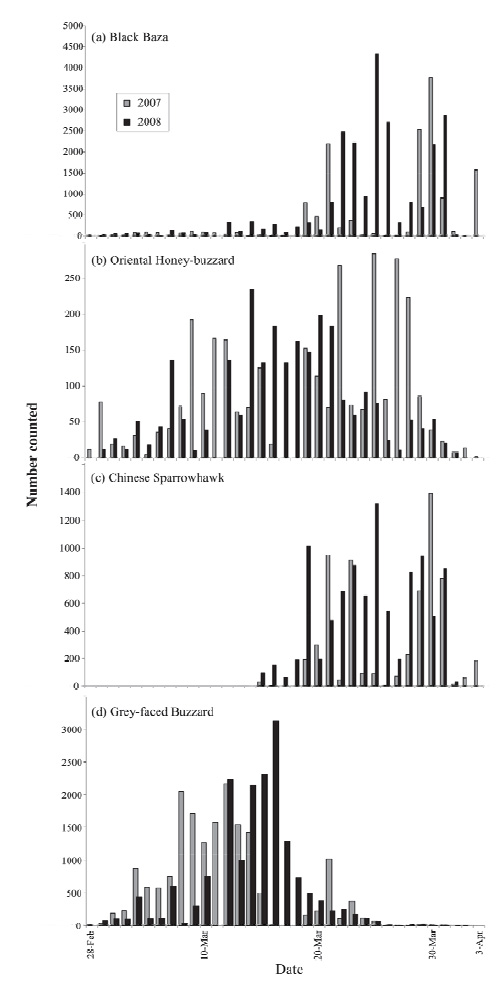 Figure 4. Number of migrant individuals counted per day during spring 2007–08 at Promsri Hill, Thailand. (a) Black Baza, (b) Oriental Honeybuzzard, (c) Chinese Sparrowhawk, (d) Grey-faced Buzzard. |
||||||||||||||||||||||||||||||||||||||||||||||||||||||||||||||||||||||||||||||||||||||||||
| For
Grey-faced Buzzard in 2007–2008, we counted 47.5 migrants/hr.
The two-year median date for peak passage was 13 March. Over 99%
of all Grey-faced Buzzards were observed migrating in flocks (789
flocks in 2007; 864 in 2008). Most flocks numbered 2–25 individuals
(Fig. 5). In 2007, the peak ten-day migration period occurred from
5 March to 14 March (Fig. 4d), averaging 1,364 migrants/day and
120.2 migrants/hr. During this time, the mean flock size (N = 457
flocks) was 27.6 birds (Standard Deviation [SD] = 26.6). In 2007,the
largest flock (175) passed the watch site between 15h00 and 16h00
on 8 March. In 2008, the peak migration timeframe for this species
occurred from 11 March to 20 March, averaging 1,389.4 migrants/day
and 128.0 migrants/hr. For these ten days, the mean flock size (N
= 551 flocks) was 25.0 birds (SD = 56.3). In 2008, the largest flock
(182) passed the watch site between 10h00 and 11h00 on 13 March.
The highest single-day count was 3,126 on 15 March 2008 (Table 1).
Compared to the hourly pattern of raptor migration at the watch
site (Fig. 3), a greater proportion of Grey-faced Buzzards (Fig.
6) were counted earlier in the day (08h00 to 11h00). In early April
2009, few (<25 total) Grey-faced Buzzards were counted, and none
were seen after 5 April 2009 (CN). We counted fewer than ten individuals of six additional species: Jerdon’s Baza Aviceda jerdoni, Common Buzzard Buteo buteo, Booted Eagle Hieraaetus pennatus, Eurasian Hobby Falco subbuteo, Oriental Hobby Falco severus and Peregrine Falcon Falco peregrinus (Table 1). Individuals of these species are difficult to detect if they are part of a larger mixed-species group, especially if flying at moderate to high altitudes. Two raptor species, Shikra Accipiter badius and Common Kestrel Falco tinnunculus, were winter residents and/or breeders in the area of Promsri Hill, so we regarded most sightings of these species to be local rather than migratory individuals. |
||||||||||||||||||||||||||||||||||||||||||||||||||||||||||||||||||||||||||||||||||||||||||
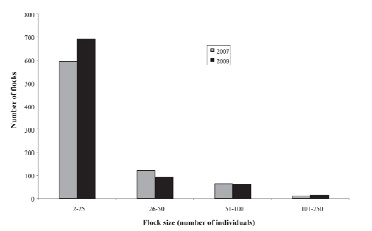 Figure 5. Number and average size of Grey-faced Buzzard flocks counted during migration in spring 2007–08 at Promsri Hill, Thailand. |
||||||||||||||||||||||||||||||||||||||||||||||||||||||||||||||||||||||||||||||||||||||||||
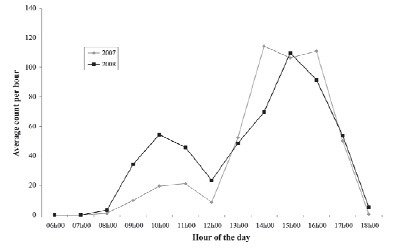 Figure 6. Mean number of Grey-faced Buzzards counted per hour during spring 2007–08 at Promsri Hill, Thailand. |
||||||||||||||||||||||||||||||||||||||||||||||||||||||||||||||||||||||||||||||||||||||||||
| DISCUSSION Our research in spring 2007–08 at Promsri Hill documents a significant northbound migration of at least 19 raptor species through southern Thailand (Table 1). Our totals represent the highest numbers of species and individuals reported for any spring watch site in Indochina. We identified two species as migrants for the first time during spring in Asia: Jerdon’s Baza and Crested Serpent Eagle. Our counts of Black Baza and Grey-faced Buzzard are the highest reported to date on the mainland during spring migration. We also observed more species on migration in this study than we did in our previous research (16 spp.) during southbound migration in autumn 2003 (DeCandido et al. 2004). Four raptor species accounted for >95% of the migration in spring 2007–08: Black Baza (38%), Grey-faced Buzzard (35%), Chinese Sparrowhawk (17%) and Oriental Honey-buzzard (6%). Based upon these data, as well as on observations made by CN in April to mid-May 2009, we suggest that most Black Bazas and Chinese Sparrowhawks migrate through southern Thailand in the last ten days of March and the first few days of April, and their migration is virtually complete in southern Thailand by 15 April. Japanese Sparrowhawk Accipiter gularis is a common southbound migrant in the area of Chumphon (DeCandido et al. 2004), and observations by CN in 2004–06 suggest that its spring migration through this area of Thailand occurs primarily from late January to late February. Grey-faced Buzzard counts are consistent from year to year, averaging 17,372/spring (Table 1), with most migrants travelling in flocks of <25 (Fig. 5). In both 2007 and 2008, our counts of Grey-faced Buzzard exceed the autumn 2003 count (DeCandido et al. 2004). At Promsri Hill, we observed a mid-morning (08h00–11h00) peak in the flight (Fig. 6) suggesting that many Grey-faced Buzzards began their migration in the area, possibly after roosting nearby overnight. Seasonally, the first Grey-faced Buzzards have been observed as early as 1 February 2005 (CN). Grey-faced Buzzard migration peaks in early to mid-March, c.5–20 March each year (Fig. 4d), and is completed by 10 April in southern Thailand. In Taiwan, part of the East Asian Oceanic Flyway (Fig. 2), data show that Grey-faced Buzzard migration peaks between 15 March and 30 March each spring (C. Chen 2006). Only one count location in Asia (at BaGuaShan, Taiwan), has reported more spring migrant Grey-faced Buzzards (c.22,000/spring) than our 2007–08 counts (see C. Chen 2006, Y.-J. Chen 2006). Further south, fewer than 100 Grey-faced Buzzards are counted annually in northbound migration at Tanjung Tuan, Malaysia (DeCandido et al. 2006, Lim and Cheung 2007, 2008), and this species is not seen every year in Singapore (Ow Yong 2008). We propose that the primary wintering area of the continental migratory population of Grey-faced Buzzards is in the highlands of northern Malaysia and southern Thailand. Our counts of migrant Oriental Honey-buzzards (2,751/spring) are low compared with recent spring counts at Tanjung Tuan, where c.24,000 were counted in 2007 (Lim and Cheung 2007), and 32,000 in 2008 (Lim and Cheung 2008). There, the peak of the migration is in mid-March (DeCandido et al. 2006). Lim and Cheung (2008) report the highest daily counts occurred on 11 March 2008 (4,102) and 14 March 2008 (4,367). At Promsri Hill, Oriental Honey-buzzards peak around 10– 25 March (Fig. 4b), suggesting that some of these migrants also passed through the area of Tanjung Tuan, and many probably migrate to our west, perhaps even through Myanmar. Migrant Oriental Honey-buzzards continue to pass Promsri Hill in small numbers (up to 100/day) in April to mid-May, and future studies might reveal how late into May migrants of this species pass through southern Thailand. Weather, particularly wind direction and speed, played the major role in the number of migrants we counted in spring 2007–08. Significantly more raptors were counted when winds had an easterly component from the Gulf of Thailand than when winds were from other directions. Easterly winds were strongest from mid- to late afternoon, as thermal activity increased, and were associated with the greatest number of raptors seen (Fig. 3). These onshore winds combined with additional easterly winds generated by the north-east low-pressure monsoon (Guo et al. 2002, Khedari et al. 2002), causing migrants to drift inland toward the watch site, particularly in spring 2008. By comparison, when easterly winds failed on 17–18 March 2007, more than 3,400 raptors were counted in migration at a site c.5 km to the east of Promsri Hill along the main road (Route 4), while less than 100 raptors passed the main watch site (K. Termtanan in litt. 2007). The diurnal pattern of spring raptor migration at Promsri Hill peaked several hours later in the day than the mid-morning peak we recorded at a nearby coastal watch site east of Chumphon during autumn 2003 (DeCandido et al. 2004). There, most raptors were observed when winds had a westerly component (DeCandido et al. 2004). Given the importance of the area for understanding patterns of northbound raptor migration in Indochina, we recommend further research at the site since we observed important differences in the pattern of the migration just between spring 2007 and 2008. During our study, we received information that large raptors, including Oriental Honey-buzzards, had been shot in the area of the watch site. Educational outreach, particularly bilingual colouring books of local birds for children, and on-line brochures of the migrants for adults (see van Kam et al. 2008), would greatly benefit raptor conservation locally and regionally. |
||||||||||||||||||||||||||||||||||||||||||||||||||||||||||||||||||||||||||||||||||||||||||
| ACKNOWLEDGEMENTS We dedicate this paper to Asian raptor scholar, Jean-Marc Thiollay. Our research in Thailand was made possible with strong support from our family and friends including Aree Nualsri and son, Narathip; Deborah Allen; Pattaporn Charoenosot; and the Promsri family including Taek, Jee, Apple, Side, Ying and Ning. Chatuphon Sawasdee of the Thai Raptor Group designed the two maps. We benefited greatly from the advice and participation of many colleagues, particularly Nurak Isarasena and Edmund Pease, Chaiyan Kasorndorkbua, Chaiwat Chinuparawat, Uthai Treesucon, William Duckworth and Philip Round. In Chumphon, Captain Narong Pethploy of the Military Police Company, Khetudomsak Camp, Chumphon Military Province, graciously gave permission and provided assistance to make Khao Klai (Promsri Hill) a wonderful observation site in spring 2007–08. Laurie Goodrich of the Hawk Mountain Sanctuary made many helpful comments that significantly improved this manuscript. Two referees, Keith Bildstein and Francesco Germi, contributed their knowledge and expertise. We also wish to thank our friends in Malaysia who introduced us to raptors in South-East Asia: Ooi Beng Yean, Chiu Sein Chiong, Cheang Kum Seng, Lim Aun Tiah, Lim Kim Chye and the late Laurence Poh. |
||||||||||||||||||||||||||||||||||||||||||||||||||||||||||||||||||||||||||||||||||||||||||
| REFERENCES Chen, C. (2006) Asian Raptor Migration Project in Taiwan: 2003– 2005. Program and abstracts, Fourth Symposium on Asian Raptors: Towards Conservation of Asian Raptors through Science and Action, 28–31 October 2005, Taiping, Perak, West Malaysia. Chen, Y.-J. (2006) Spring migration of the Grey-faced Buzzard in the central and southern Taiwan. M.S. thesis, Institute of Wildlife Conservation, National Ping-tung University of Science and Technology, Taiwan [in Chinese with English Abstract]. 47 pp. DeCandido, R., Nualsri, C., Allen, D. and Bildstein, K. L. (2004) Autumn 2003 raptor migration at Chumphon, Thailand: a globally significant raptor migration watch site. Forktail 20: 49–54. DeCandido, R., Allen, D. and Bildstein, K. (2006) Spring migration of Oriental Honey-buzzards and other raptors at Tanjung Tuan, Malaysia, 2000–2001. Forktail 22: 156–160. DeCandido, R., Kasorndorkbua, C., Nualsri, C., Chinuparawat, C. and Allen, D. (2008) Raptor migration in Thailand. BirdingASIA 10: 16–22. Germi, F., Young, G. S., Salim, A., Pangimangen, W. and Schellekens, M. (2009) Over-ocean raptor migration in a monsoon regime: spring and autumn 2007 on Sangihe, north Sulawesi, Indonesia. Forktail 25: 104–116. Guo, Y., Toh, J., Zhang, Z. M., Lin, I.-I. and Khoo, V. H. S. (2002) Investigation of the north-east monsoon characteristics in the region of South East Asia using ERS wind scatterometer data. Geoscience and Remote Sensing, 1997. IGARSS ’97. Remote Sensing – A Scientific Vision for Sustainable Development., 1997 IEEE International 2: 845–847. Herremans, M. and Louette, M. (2000) A partial post-juvenile molt and transitional plumage in the Shikra (Accipter badius) and Grey Frog Hawk (Accipiter soloensis). J. Raptor Research 34: 249–261. Higuchi, H., Shiu, H. J., Nakamura, H., Uematsu, A., Kuno, K., Saeki, M., Hotta, M., Tokita, K., Moriya, E., Morishita, E. and Tamura, M. (2005) Migration of Honey-buzzards Pernis ptilorhyncus based on satellite tracking. Ornithological Science 4: 109–115. Inskipp, T., Lindsey, N. and Duckworth, W. (1996) An annotated checklist of the birds of the Oriental region. Sandy, Beds, U.K.: Oriental Bird Club. Inskipp, T., Lindsey, N. and Duckworth, W. (2001) Checklist of the birds of the Oriental Region. Oriental Bird Club. www.orientalbirdclub.org/publications/checklist/obcchecklist.txt van de Kam, J., Battley, P. F., McCaffery, B. J., Rogers, D., Hong, J.-S, Moore, N., Yong-Ki, J., Lewis, J. and Piersma, T. (2008) Invisible connections. Available On-line: http://www.wetlands.org/ LinkClick.aspx?fileticket=qI4xkTHeeN0%3d&tabid=56 Kasorndorkbua, C., Chinuparawat, C. and Nualsri, C. (2008) A photographic guide to the raptors of Thailand. Bangkok: Thai Raptor Group (Amarin Printing and Publishing, Co.Ltd). [in Thai with English Introduction]. 328 pp. Khedari, J., Sangprajak, A. and Hirunlabh, J. (2002) Thailand climatic zones. Renewable Energy 25: 267–280. Kugai, K. (1996) Autumn migration of Butastur indicus Grey-faced Buzzard-eagle in Japan. Bull. Okinawa Prefectural Mus. 1996: 154– 172. Lekagul, B., Round, P. D., Komolphalin, K. and Wongkalasin, M. (1991) A guide to the birds of Thailand. Bangkok: Saha Karn Bhat Co. Ltd. Lim, A. T. and Cheung, N. (2007) A report on the monitoring of raptor migration at Tanjung Tuan, Peninsular Malaysia – spring 2007. Kuala Lumpur: Malaysian Nature Society. Lim, A. T. and Cheung, N. (2008) A report on the monitoring of raptor migration at Tanjung Tuan, Peninsular Malaysia – spring 2008. Kuala Lumpur: Malaysian Nature Society. Ow Yong, A. (2008) Summary report on the raptor migration in Singapore from autumn 2007 to spring 2008 (ed. K. Yee). Available online: http://wildbirdsingapore.nss.org.sg/indexE.html Preacher, K. J. (2001) Calculation for the chi-square test: an interactive calculation tool for chi-square tests of goodness of fit and independence [Computer software]. Available from http:// www.quantpsy.org. Robson, C. (2002) Birds of Thailand. London: New Holland. Shiu, H. J., Tokita, K., Morishita, E., Hiraoka, E., Wu, Y., Nakamura, H. and Higuchi, H. (2006) Route and site fidelity of two migratory raptors: Grey-faced Buzzards Butastur indicus and Honey-buzzards Pernis apivorus. Ornithological Science 5: 151–156. Wells, D. R. (1999) The birds of the Thai-Malay Peninsula. London: Academic Press. |
||||||||||||||||||||||||||||||||||||||||||||||||||||||||||||||||||||||||||||||||||||||||||
| Kindly
submitted by: Robert DeCandido, 1831 Fowler Avenue, The Bronx, New York 10462 U.S.A. Email: rdcny@earthlink.net |
||||||||||||||||||||||||||||||||||||||||||||||||||||||||||||||||||||||||||||||||||||||||||
| Tweet | ||||||||||||||||||||||||||||||||||||||||||||||||||||||||||||||||||||||||||||||||||||||||||

A Guide to Birdwatching in Thailand. Copyright © 2004-2017 thaibirding.com. All rights reserved.